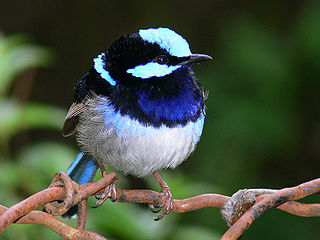
In taxonomy, binomial nomenclature, also called binary nomenclature, is a formal system of naming species of living things by giving each a name composed of two parts, both of which use Latin grammatical forms, although they can be based on words from other languages. Such a name is called a binomial name, a binomen, binominal name, or a scientific name; more informally it is also historically called a Latin name. In the ICZN, the system is also called binominal nomenclature, "binomi'N'al" with an "N" before the "al", which is not a typographic error, meaning "two-name naming system".

Rhododendron is a very large genus of about 1,024 species of woody plants in the heath family (Ericaceae). They can be either evergreen or deciduous. Most species are native to eastern Asia and the Himalayan region, but smaller numbers occur elsewhere in Asia, and in North America, Europe and Australia.

The family Psittacidae or holotropical parrots is one of three families of true parrots. It comprises the 12 species of subfamily Psittacinae and 167 of subfamily Arinae including several species that have gone extinct in recent centuries. Some of the most iconic birds in the world are represented here, such as the blue-and-yellow macaw among the New World parrots and the grey parrot among the Old World parrots.

The Accipitridae is one of the three families within the order Accipitriformes, and is a family of small to large birds of prey with strongly hooked bills and variable morphology based on diet. They feed on a range of prey items from insects to medium-sized mammals, with a number feeding on carrion and a few feeding on fruit. The Accipitridae have a cosmopolitan distribution, being found on all the world's continents and a number of oceanic island groups. Some species are migratory. The family contains 255 species which are divided into 70 genera.

The Australasian wrens are a family, Maluridae, of small, insectivorous passerine birds endemic to Australia and New Guinea. While commonly known as wrens, they are unrelated to the true wrens. The family comprises 32 species in six genera.

Antirrhinum is a genus of plants commonly known as dragon flowers or snapdragons because of the flowers' fancied resemblance to the face of a dragon that opens and closes its mouth when laterally squeezed. They are also sometimes called toadflax or dog flower. They are native to rocky areas of Europe, the United States, Canada, and North Africa. Antirrhinum species are widely used as ornamental plants in borders and as cut flowers.

Ovenbirds or furnariids are a large family of small suboscine passerine birds found from Mexico and Central to southern South America. They form the family Furnariidae. This is a large family containing around 315 species and 70 genera. The ovenbird, which breeds in North America, is not a furnariid – rather it is a distantly related bird of the wood warbler family, Parulidae.
Squalidae, more commonly known as dogfish, dog sharks, or spiny dogfish, are one of several families of sharks categorized under Squaliformes, making it the second largest order of sharks, numbering 119 species across 7 families. Having earned their name after a group of fishermen reportedly observed the species chasing down smaller fish in dog-like packs, dogfish have slender, streamlined bodies, usually more compact in comparison to other species, and a pointed snout. Dogfish likewise have two dorsal fins, each with smooth spines, but no anal fin, and their skin is generally rough to the touch. As the species reaches adulthood, males usually measure a maximum of 100 cm, while females typically measure 125 cm long. The species therefore exhibits female-dominant sexual dimorphism.

Mountain coatis are two species of procyonid mammals from the genus Nasuella. Unlike the larger coatis from the genus Nasua, mountain coatis only weigh 1.0–1.5 kilograms (2.2–3.3 lb) and are endemic to the north Andean highlands in South America.

Caniformia is a suborder within the order Carnivora consisting of "dog-like" carnivorans. They include dogs, bears, raccoons, and mustelids. The Pinnipedia are also assigned to this group. The center of diversification for the Caniformia is North America and northern Eurasia. Caniformia stands in contrast to the other suborder of Carnivora, the Feliformia, the center of diversification of which was in Africa and southern Asia.

Livistona is a genus of palms, the botanical family Arecaceae, native to southeastern and eastern Asia, Australasia, and the Horn of Africa. They are fan palms, the leaves with an armed petiole terminating in a rounded, costapalmate fan of numerous leaflets.

Acacia, commonly known as wattles or acacias, is a genus of about 1084 species of shrubs and trees in the subfamily Mimosoideae of the pea family Fabaceae. Initially, it comprised a group of plant species native to Africa, South America and Australasia, but is now reserved for species mainly from Australia, with others from New Guinea, Southeast Asia and the Indian Ocean. The genus name is Neo-Latin, borrowed from the Greek ἀκακία, a term used by Dioscorides for a preparation extracted from the leaves and fruit pods of Vachellia nilotica, the original type of the genus. In his Pinax (1623), Gaspard Bauhin mentioned the Greek ἀκακία from Dioscorides as the origin of the Latin name.

Rhomaleosaurus is an extinct genus of Early Jurassic rhomaleosaurid pliosauroid known from Northamptonshire and from Yorkshire of the United Kingdom. It was first named by Harry Seeley in 1874 and the type species is Rhomaleosaurus cramptoni. It was one of the earliest large marine reptile predators which hunted in the seas of Mesozoic era, measuring about 7 metres (23 ft) long. Like other pliosaurs, Rhomaleosaurus fed on ichthyosaurs, ammonites and other plesiosaurs.

Raphicerus is a genus of small antelopes of the tribe Neotragini.
Plasmodium azurophilum is a species of the genus Plasmodium. Like all species in this genus it is a parasite of both vertebrates and insects. The vertebrate hosts are anole lizards.

Salvia is the largest genus of plants in the sage family Lamiaceae, with nearly 1000 species of shrubs, herbaceous perennials, and annuals. Within the Lamiaceae, Salvia is part of the tribe Mentheae within the subfamily Nepetoideae. One of several genera commonly referred to as sage, it includes two widely used herbs, Salvia officinalis and Salvia rosmarinus.

Picramniaceae is a small, mainly neotropical family of four genera Aenigmanu, Alvaradoa, Nothotalisia and Picramnia. The family is the only member of the order Picramniales. Members of the family were formerly placed in the family Simaroubaceae or misidentified as species in the family Sapindaceae, in the order Sapindales. The most recent standard classification of the Angiosperms distinguishes it as a separate family and order. It belongs to the malvids, one of the three groups that constitute the rosids.

Allium is a genus of monocotyledonous flowering plants with hundreds of species, including the cultivated onion, garlic, scallion, shallot, leek, and chives. The generic name Allium is the Latin word for garlic, and the type species for the genus is Allium sativum which means "cultivated garlic".

The Solanaceae, or the nightshades, are a family of flowering plants that ranges from annual and perennial herbs to vines, lianas, epiphytes, shrubs, and trees, and includes a number of agricultural crops, medicinal plants, spices, weeds, and ornamentals. Many members of the family contain potent alkaloids, and some are highly toxic, but many—including tomatoes, potatoes, eggplant, bell and chili peppers—are used as food. The family belongs to the order Solanales, in the asterid group and class Magnoliopsida (dicotyledons). The Solanaceae consists of about 98 genera and some 2,700 species, with a great diversity of habitats, morphology and ecology.

Anolis krugi, the olive bush anole, Krug's anole, or orange dewlap anole, is a species of lizard in the family Dactyloidae. The species is found in Puerto Rico.


















